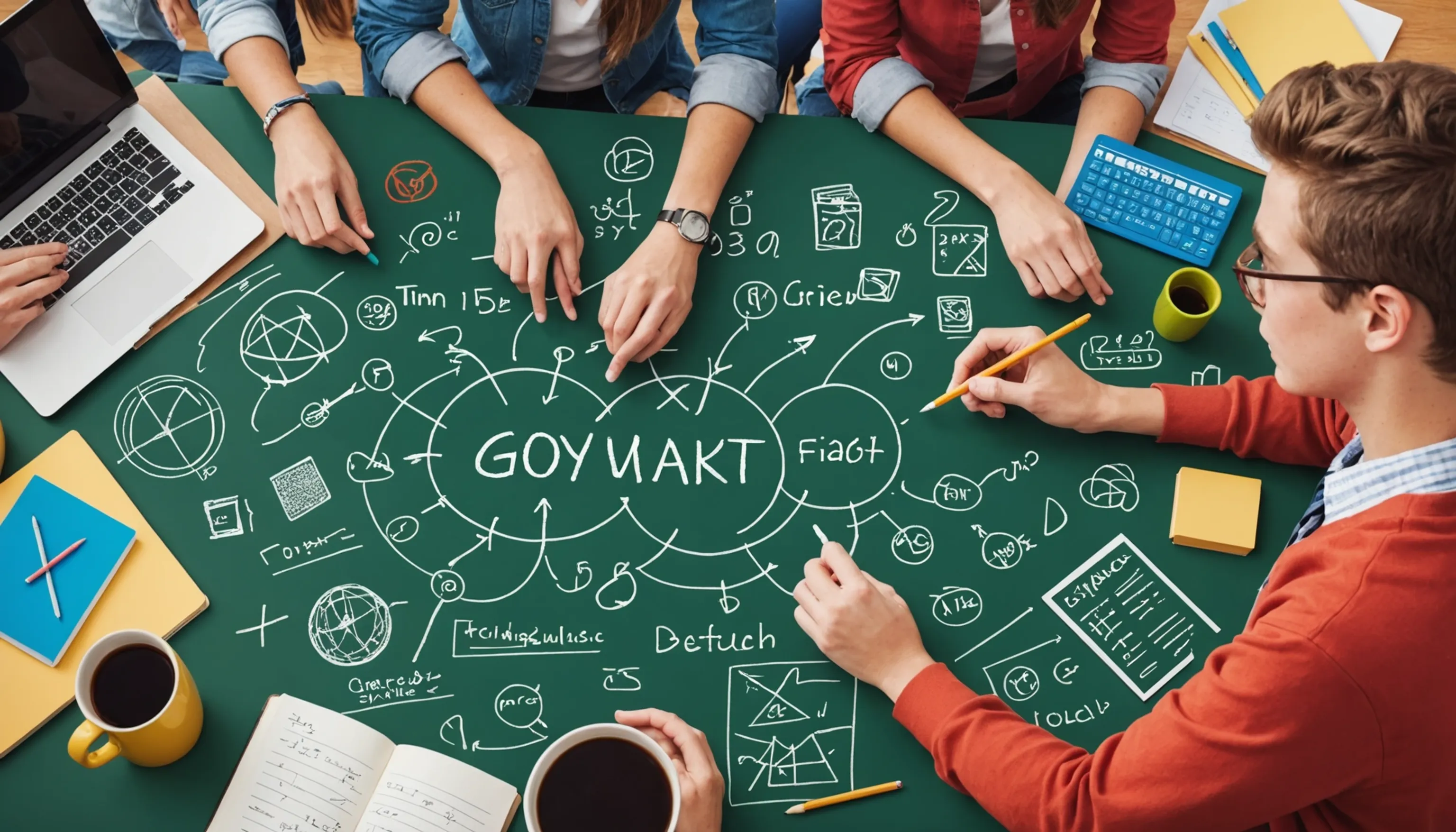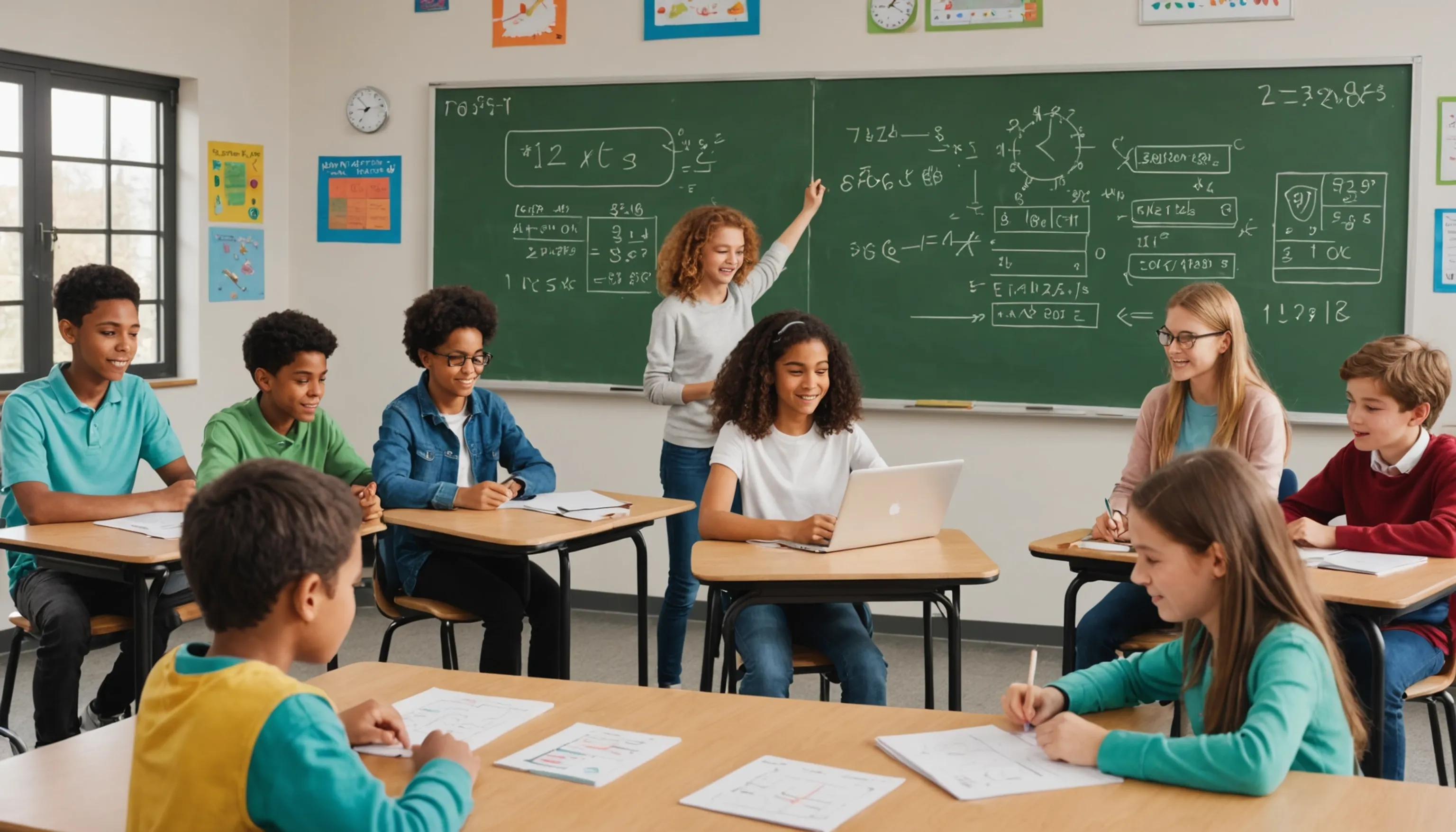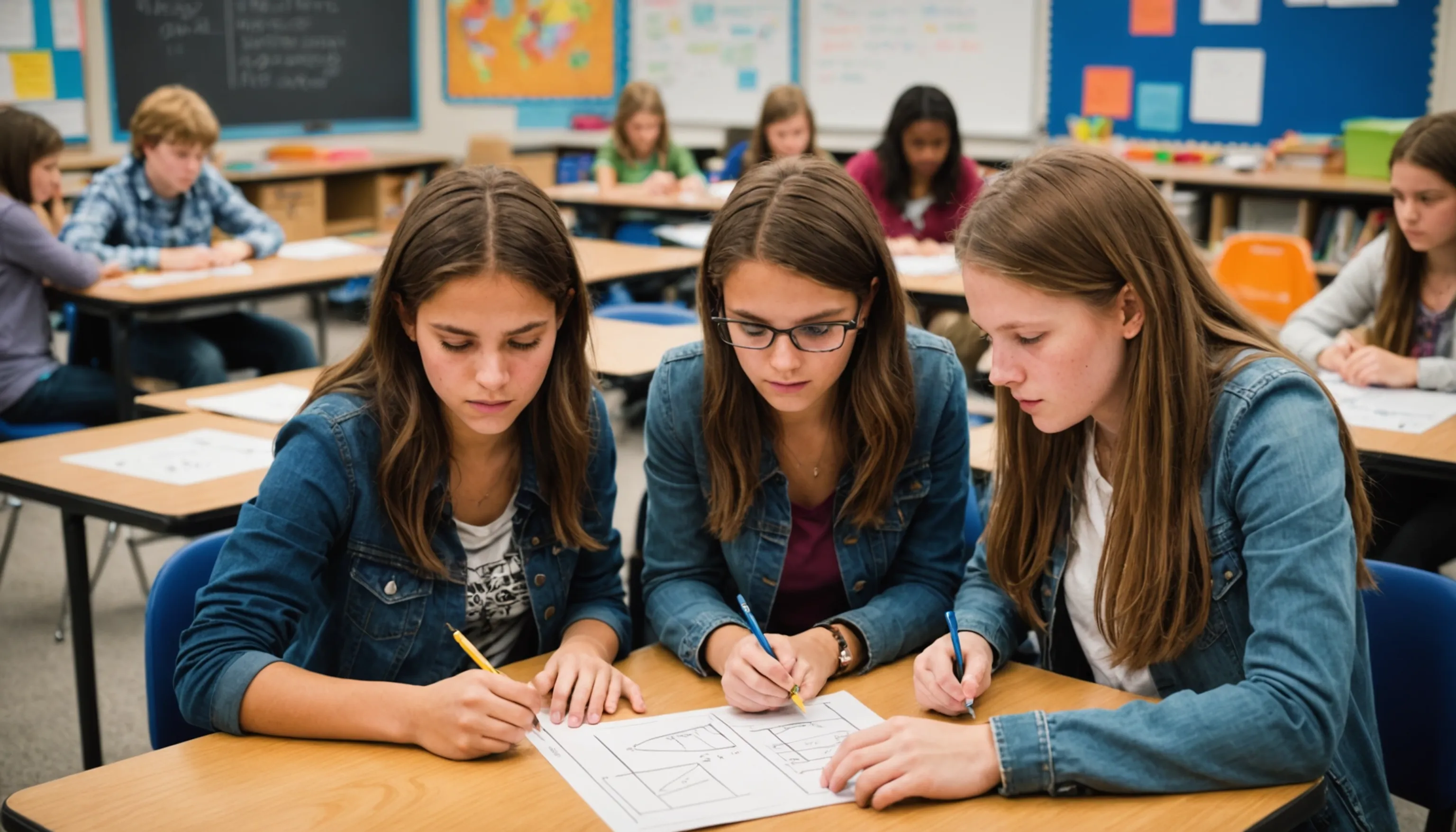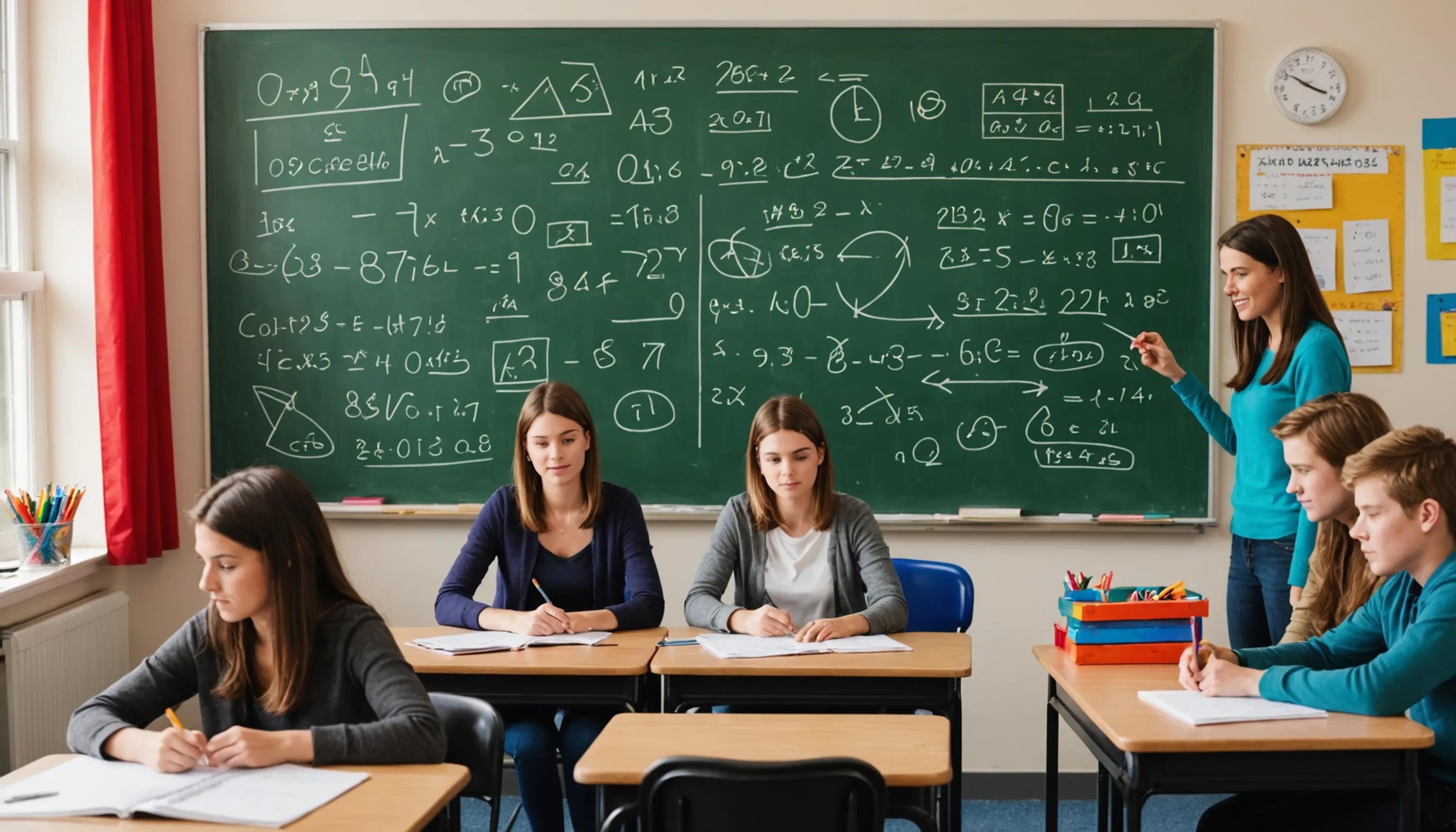Innovative Math Teaching Strategies
 HvWHenry van Wagenberg
HvWHenry van Wagenberg
Innovative Math Teaching Strategies for Teenagers
Innovative math teaching strategies for teenagers are essential to engage students and enhance their learning experience. These strategies focus on making math relevant and exciting. For instance, incorporating project-based learning allows students to apply mathematical concepts to real-life situations, fostering deeper understanding.
Using technology in math education, such as interactive software and online resources, can also boost interest and comprehension. Additionally, integrating gamification elements into lessons transforms traditional math learning into fun challenges, capturing teenagers' attention and motivating them to participate actively.
Project-Based Learning in Math
Project-Based Learning (PBL) in math is an effective strategy that promotes critical thinking and problem-solving skills among teenagers. Instead of traditional lectures, PBL encourages students to engage with real-world problems that require the application of mathematical concepts.
For instance, students might work on a project that involves designing a budget for a school event. This requires them to apply budgeting principles, calculate costs, and manage resources, all while collaborating with their peers. By tackling such projects, students can see the relevance of math in everyday life.
Key components of successful PBL include:
- Real-World Relevance: Projects should relate to real-life situations that interest teenagers, making math more engaging.
- Student Choice: Allowing students to choose their projects fosters ownership and motivation.
- Collaboration: Working in teams encourages communication and the sharing of diverse ideas.
Additionally, PBL promotes self-directed learning. Students take the initiative to research, ask questions, and seek solutions, which builds their confidence. Assessment in PBL can also be more holistic, focusing on both the final product and the process, including teamwork and presentation skills.
Incorporating Project-Based Learning into math education not only enhances comprehension but also prepares teenagers for future academic and career challenges by equipping them with essential life skills.
Incorporating Technology in Math Education
Incorporating technology in math education can significantly enhance the learning experience for teenagers. With the advent of digital tools, educators can create an interactive and engaging environment that caters to diverse learning styles. For instance, using graphing software allows students to visualize complex equations and functions, making abstract concepts more tangible.
Online platforms and apps offer a wealth of resources, from practice problems to instructional videos. These tools enable personalized learning, allowing students to progress at their own pace. For example, platforms like Khan Academy provide tailored math exercises that adapt to each student's skill level, ensuring they grasp foundational concepts before moving on to advanced topics.
Another effective method is the use of interactive whiteboards and smart devices in the classroom. These tools facilitate collaborative problem-solving, where students can work together on math problems and share their thought processes in real time. This not only promotes engagement but also helps develop essential communication skills.
Furthermore, incorporating math games and simulations can make learning fun and competitive. Gamification encourages students to tackle challenges and rewards them for their achievements, fostering a positive attitude towards math.
Ultimately, integrating technology in math education not only enhances understanding but also prepares teenagers for a tech-driven world, equipping them with the skills necessary for future success in various fields.

Gamification of Math Lessons
The gamification of math lessons is an innovative approach that transforms traditional math education into an engaging and interactive experience for teenagers. By integrating game elements into the learning process, educators can motivate students to participate actively and enjoy math more than ever.
Gamification can take many forms, such as using points, levels, and rewards systems to encourage progress. For example, teachers can create a math challenge where students earn points for completing exercises correctly or for helping their peers. This competition fosters a sense of achievement and encourages teamwork, making learning more enjoyable.
Another effective method is to incorporate educational games that focus on specific mathematical concepts. Online platforms like Prodigy and Kahoot! offer interactive math games that adapt to each student’s level, ensuring that they’re challenged appropriately while having fun. These platforms also allow for real-time feedback, helping students recognize their strengths and areas for improvement.
Moreover, gamification can be extended beyond the classroom. Math competitions and clubs provide opportunities for students to apply their skills in a fun, competitive environment. These extracurricular activities not only enhance their math abilities but also build camaraderie among peers.
In conclusion, the gamification of math lessons effectively engages teenagers, making math more relatable and enjoyable. By leveraging game mechanics, educators can foster a positive attitude towards math, ultimately leading to improved understanding and academic success.
Collaborative Learning Techniques
Collaborative learning techniques are essential in math education, fostering teamwork and enhancing problem-solving skills among teenagers. By working together on math problems, students can share diverse perspectives and strategies, leading to a deeper understanding of concepts.
Techniques such as think-pair-share encourage students to discuss their thoughts before sharing with the larger group, promoting confidence. Group projects allow for collaborative problem-solving, where peers tackle complex problems together. These methods not only improve math skills but also enhance communication and interpersonal abilities, preparing students for future collaborative environments.
Peer Tutoring Programs
Peer tutoring programs are an effective way to enhance math education for teenagers. These programs involve students helping each other, creating a supportive learning environment that fosters collaboration and understanding. By pairing students who excel in math with those who may struggle, peer tutoring can bridge gaps in knowledge while promoting confidence in both tutors and tutees.
One significant advantage of peer tutoring is that it allows students to learn at their own pace. When a student struggles with a concept, a peer tutor can provide explanations in relatable terms, making the material more accessible. This personalized approach often leads to a deeper understanding of mathematical concepts.
Moreover, peer tutoring programs encourage the development of communication skills. Tutors must articulate their thought processes clearly, while tutees learn to ask questions and express their difficulties. This exchange helps both parties refine their understanding and enhances their ability to work collaboratively.
Schools can implement peer tutoring in various ways, such as during designated study periods, after-school sessions, or even through online platforms. It’s essential to train peer tutors to ensure they possess the necessary skills and knowledge to assist their peers effectively.
In conclusion, peer tutoring programs not only improve math skills but also foster a sense of community and support among students. By encouraging collaboration and communication, these programs prepare teenagers for future academic and social challenges.

Group Problem-Solving Activities
Group problem-solving activities are an invaluable component of math education that encourages teamwork and critical thinking among teenagers. These activities involve students working collaboratively to tackle complex math problems, fostering a sense of community while enhancing their analytical skills.
One effective approach is to present students with real-world scenarios that require mathematical solutions. For instance, a group might be tasked with planning a community event, which involves budgeting, scheduling, and resource allocation. This type of project not only engages students but also demonstrates the practical applications of math in everyday life.
Additionally, structured activities such as math relays or puzzle competitions can stimulate healthy competition while promoting collaboration. In a math relay, for example, teams race against the clock to solve a series of problems, encouraging quick thinking and cooperative strategies. These fast-paced environments make learning fun and exciting.
Group problem-solving also enhances communication skills, as students must discuss their thought processes and justify their solutions to their peers. This exchange of ideas helps students develop a deeper understanding of mathematical concepts and encourages them to view problems from multiple angles.
To maximize the benefits of group problem-solving activities, teachers should facilitate discussions and guide students in reflecting on their strategies and outcomes. In conclusion, these collaborative experiences not only improve math proficiency but also prepare teenagers for future academic and professional challenges by building essential life skills.
Math Competitions and Clubs
Math competitions and clubs play a crucial role in enhancing mathematical skills and fostering a love for math among teenagers. These extracurricular activities provide a platform for students to challenge themselves, engage with peers, and apply their math knowledge in a competitive environment.
Participating in math competitions, such as the American Mathematics Competitions (AMC) or local math leagues, allows students to tackle complex problems that go beyond the regular curriculum. These contests often require creative problem-solving and critical thinking, helping participants develop higher-level math skills. Moreover, the thrill of competition can motivate students to deepen their understanding of mathematical concepts.
Math clubs also serve as an excellent avenue for students to collaborate and explore mathematics in a fun, informal setting. Within these clubs, members can work on challenging problems, prepare for upcoming competitions, and engage in discussions about various math topics. This collaborative environment encourages students to share strategies, learn from one another, and develop a stronger grasp of the subject.
Additionally, math competitions and clubs often foster a sense of community. Students with a shared interest in math can form friendships and support one another in their academic pursuits. Educators can enhance these experiences by organizing workshops and inviting guest speakers from math-related fields to inspire students.
In summary, math competitions and clubs not only improve mathematical skills but also instill a passion for the subject, preparing teenagers for future academic and career opportunities.
Real-World Applications of Math
Real-world applications of math are essential for helping teenagers understand the relevance of mathematical concepts in everyday life. By connecting math to real-life situations, educators can make learning more engaging and meaningful.
For instance, math is crucial in fields such as finance, where understanding percentages, interest rates, and budgeting are vital skills. Students can learn to create personal budgets, helping them grasp the importance of financial literacy. Another example is in architecture and engineering, where geometry and algebra are used to design and construct buildings.
Additionally, math is integral in various careers, from science and technology to healthcare and data analysis. By incorporating real-world problems into lessons, teachers can illustrate how math is used in different professions, motivating students to see its value beyond the classroom.
Ultimately, highlighting these applications fosters a positive attitude towards math and encourages students to apply their skills in practical ways.
Integrating Math with Everyday Life
Integrating math with everyday life is an effective way to enhance teenagers' understanding and appreciation of mathematics. By demonstrating how math is involved in daily activities, educators can make the subject more relatable and engaging.
One practical approach is to incorporate real-life scenarios into lessons. For example, students can calculate the total cost of groceries while shopping, including discounts and sales tax. This hands-on experience not only reinforces arithmetic skills but also teaches them about budgeting and financial literacy.
Another effective method is to explore math through cooking and baking. Recipes require precise measurements and conversions, allowing students to practice fractions and ratios. This not only enhances their mathematical skills but also encourages creativity and collaboration in the kitchen.
Additionally, integrating math with sports can capture students' interests. Analyzing statistics, such as player performance or game scores, helps them understand concepts like averages and probabilities in a context they enjoy.
Field trips to local businesses or industries can further illustrate the importance of math in various careers. For instance, visiting a manufacturing plant can highlight how math is used in production and quality control.
In conclusion, by connecting math to everyday life, educators can foster a positive attitude towards the subject and help teenagers recognize its value in their daily decisions and future careers.
Field Trips Related to Math Concepts
Field trips related to math concepts provide teenagers with hands-on experiences that enhance their understanding of mathematics in real-world contexts. These excursions can make abstract concepts more tangible and demonstrate the practical applications of math in various fields.
One engaging option is visiting a local science museum, where students can explore exhibits that incorporate mathematical principles. For instance, interactive displays on geometry, physics, and engineering can illustrate how math is used in designing structures, understanding motion, and analyzing data.
Another valuable field trip could involve a visit to a construction site or architectural firm. Here, students can witness how architects and engineers apply geometry and measurement in real-time to create buildings and infrastructure. This experience not only reinforces math concepts but also provides insight into potential career paths in STEM fields.
Additionally, trips to financial institutions can help students grasp the importance of math in finance. Learning about budgeting, interest rates, and financial planning can empower them to make informed decisions in their personal lives.
Moreover, agricultural centers or farms can highlight the role of math in understanding growth patterns, yield calculations, and resource management. These experiences foster a deeper appreciation for the math that underpins everyday decisions.
In conclusion, field trips related to math concepts enrich students' learning experiences by connecting classroom knowledge to real-life applications, inspiring them to see the relevance of math in their lives.
Guest Speakers in Math Fields
Inviting guest speakers in math fields is an excellent way to enrich the educational experience for teenagers and inspire their interest in mathematics. These speakers, who often have diverse backgrounds and expertise, can provide valuable insights into how math is applied in various professions, making the subject more relevant and engaging.
For instance, a mathematician can discuss the importance of mathematical modeling in scientific research, illustrating how equations and algorithms drive discoveries in fields like physics or biology. This real-world connection helps students understand the significance of their studies and the potential impact of math on everyday life.
Additionally, professionals from finance, engineering, or technology sectors can share their experiences, emphasizing how they use math in their daily work. For example, an accountant might explain how budgeting and financial analysis involve critical math skills, while an engineer could demonstrate how geometry and calculus are essential for designing structures.
Moreover, guest speakers can also provide career guidance, helping students explore potential pathways in STEM fields. They can share their educational journeys, challenges, and successes, encouraging students to consider math-related careers that they may not have previously contemplated.
By incorporating guest speakers into the curriculum, educators create a dynamic learning environment that fosters curiosity and motivation. These interactions not only enhance students’ understanding of math but also inspire them to pursue their passions and recognize the value of math in various careers.
